Identifying Energy-Use Behavior and Energy-Use Profiles of Hotel Guests
Abstract
:1. Introduction
2. Objectives
3. Background
3.1. Motivation-Opportunity-Ability (MOA) Model
3.2. Norm Activation Model (NAM)
- Ascription of Responsibility means the assignment of responsibility for taking actions or attribution of responsibility for the negative consequences of not acting proactively [41].
3.3. Theory of Planned Behavior (TPB)
- Attitude illustrates occupants’ overall evaluation of the behavior or the degree of individuals’ performance of the behavior that is either positively or negatively valued by the occupants [28].
- Social Norms are divided into two major sub-categories: subjective and descriptive norms. First, subjective norm would apply to energy consumption when occupants believes that they are under social pressure by surrounding people/peers to engage or not engage in energy saving behaviors [8,27]. Second, descriptive norm captures the perceptions of others’ actual behaviors (e.g., the perception of companions’ actual wasting or saving energy behaviors in hotel buildings) [8,42,43].
3.4. Pro-Environmental Behavior (PEB)
- Environmental Concern refers to the evaluation of facts, or an attitude towards facts with consequences for the environment [50,51]. The Environmental Concern of occupants may increase when they understand the scientific relationship between personal behavior, such as energy consumption and global warming [24].
- Physical Effort refers to the physical demonstration of occupants toward conducting specific actions such as reducing energy consumption. When occupants feel that the actions are bothersome or inconvenient to do, they may not conduct them [32].
4. Methodology
4.1. Incorporating Energy-Related Behavior Models
4.2. Developing Energy-Use Behavior Hypotheses and Their Relevant Measures
4.3. Energy-Use Survey Design
4.4. Energy Behavior Data Analysis
4.5. Energy-Use Behavior
4.6. Energy-Use Profiles
5. Integrated Energy-Use Framework Implementation
5.1. Conducting Energy-Use Survey
5.2. Energy Behavior Reliability Analysis
5.3. Identifying Energy-Use Behavior of Hotel Guests
5.4. Identifying Energy-Use Profiles of Hotel Guests
6. Results and Discussion
- Motivation level: the results for the Motivation level of hotel guests indicated that about 26% of the hotel guests have Low energy-use behavior, about 24% have Medium-Low energy-use behavior, about 29% have Medium-High energy-use behavior, and about 21% have High energy-use behavior (see Figure 9).
- Opportunity level: the results for the Opportunity level of hotel guests showed that about 26% of the hotel guests have Low energy-use behavior, about 25% have Medium-Low energy-use behavior, about 30% have Medium-High energy-use behavior, and about 19% have High energy-use behavior (see Figure 10).
- Ability level: the results for the Ability level of hotel guests indicated that about 19% of the hotel guests have Low energy-use behavior, about 34% have Medium-Low energy-use behavior, about 20% have Medium-High energy-use behavior, and about 27% have High energy-use behavior (see Figure 11).
7. Conclusions
Author Contributions
Funding
Institution Review Board Statement
Informed Consent Statement
Data Availability Statement
Conflicts of Interest
Appendix A
| Questions to Measure H1–Motivation | MOA | |
| 1 | How often do you turn off the lights in your hotel room when not in use to save energy (e.g., sleeping, when not needed, and when not in the room)? Never Rarely Sometimes Often Always | M |
| 2 | How often do you adjust thermostat settings (i.e., heat down in winter or up in the summer) in your hotel room to save energy? Never Rarely Sometimes Often Always | M |
| 3 | When your hotel room is chilly/cold, which one are you most likely to do?
| M |
| 4 | When your hotel room is warm/hot, which one are you most likely to do?
| M |
| 5 | I turn off the lights in my hotel room when my hotel room is bright enough. Never Rarely Sometimes Often Always | M |
| 6 | What best describes how you think about conserving energy in your hotel room?
| M |
| 7 | My personal comfort in a hotel room is more important to me than reducing energy consumption. Strongly Disagree Disagree Neither Agree nor Disagree Agree Strongly Agree | M |
| 8 | My energy consumption behavior in my hotel room is different when I travel for business purposes than when I travel for pleasure. Strongly Disagree Disagree Neither Agree nor Disagree Agree Strongly Agree | M |
| 9 | How often do you use the stairs to access or to leave your hotel room? Never Rarely Sometimes Often Always | M |
| 10 | How often do you use the elevator to access or leave your hotel room? Never Rarely Sometimes Often Always | M |
| Questions to Measure H2–Personal Norms | MOA | |
| 11 | I feel morally obligated to reduce energy consumption in my hotel room. Strongly Disagree Disagree Neither Agree nor Disagree Agree Strongly Agree | M |
| 12 | I feel good about myself when I save energy in my hotel room. Strongly Disagree Disagree Neither Agree nor Disagree Agree Strongly Agree | M |
| Questions to Measure H3–Ascription of Responsibility | MOA | |
| 13 | Hotel management is responsible for reducing energy consumption in the hotel, not the guest. Strongly Disagree Disagree Neither Agree or Disagree Agree Strongly Agree | M |
| 14 | My personal contribution to the hotel’s energy consumption will be negligible. Strongly Disagree Disagree Neither Agree or Disagree Agree Strongly Agree | M |
| 15 | I believe that every hotel guest is responsible for the energy consumption of hotel buildings. Strongly Disagree Disagree Neither Agree nor Disagree Agree Strongly Agree | M |
| Questions to Measure H4–Attitude | MOA | |
| 16 | When travelling, saving energy in my hotel room is: Not important at all Slightly important Somewhat important Moderately important Very important | M |
| Questions to Measure H5–Environmental Concern | MOA | |
| 17 | How much are you concerned about your personal energy consumption in your hotel room? Not at all concerned Slightly concerned Somewhat concerned Moderately concerned Extremely concerned | M |
| 18 | I think environmental problems are important and cannot be ignored. Strongly Disagree Disagree Neither Agree nor Disagree Agree Strongly Agree | M |
| Questions to Measure H6–Social Norms | MOA | |
| 32 | In general, the hotel management expects me to turn off the lights when leaving the room or when not needed. Never Rarely Sometimes Often Always | O |
| 33 | In general, my room companion(s) expect me to turn off the lights when leaving the room or when not needed. Never Rarely Sometimes Often Always | O |
| 34 | The hotel management expects me to shut down or change the HVAC thermostat setting when leaving the room or when not needed. Never Rarely Sometimes Often Always | O |
| 35 | My room companion(s) expects me to shut down or change the HVAC thermostat setting when leaving room or when not needed. Never Rarely Sometimes Often Always | O |
| 36 | In general, the hotel management expects me to use the ceiling fan and adjust the thermostat setting when leaving room or when not needed. Never Rarely Sometimes Often Always | O |
| 37 | In general, my room companion(s) expects me to use the ceiling fan and adjust the thermostat setting when leaving room or when not needed. Never Rarely Sometimes Often Always | O |
| 38 | My room companion(s) is/are concerned about his/her energy consumption during our stay at a hotel room. Never Rarely Sometimes Often Always | O |
| 39 | My room companion(s) try to reduce his/her energy consumption during our stay at a hotel room. Never Rarely Sometimes Often Always | O |
| Questions to Measure H7–Hotel Management Support | MOA | |
| 40 | Hotels that I have visited often encourage guests to save energy by providing education and information. Strongly Disagree Disagree Neither Agree nor Disagree Agree Strongly Agree | O |
| 41 | Hotels that I have visited are often committed to saving energy. Strongly Disagree Disagree Neither Agree nor Disagree Agree Strongly Agree | O |
| Questions to Measure H8–Physical Effort | MOA | |
| 42 | It usually takes more physical effort than it is worth to reduce energy consumption in a hotel room. Strongly Disagree Disagree Neither Agree nor Disagree Agree Strongly Agree | O |
| Questions to Measure H9–Environmental Perceived Knowledge | MOA | |
| 19 | Energy conservation is a topic that people like me can understand. Strongly Disagree Disagree Neither Agree nor Disagree Agree Strongly Agree | A |
| 20 | I am aware of the effects of global warming. Not at all aware Slightly aware Somewhat aware Moderately aware Extremely aware | A |
| 21 | I know how to reduce the cooling load (e.g., AC usage) in my hotel room. Strongly Disagree Disagree Neither Agree nor Disagree Agree Strongly Agree | A |
| 22 | I know how to reduce the heating load (e.g., usage of furnace) in my hotel room. Strongly Disagree Disagree Neither Agree nor Disagree Agree Strongly Agree | A |
| 23 | I know how to reduce the lighting usage in my hotel room (e.g., open the blinds to allow for natural light). Strongly Disagree Disagree Neither Agree nor Disagree Agree Strongly Agree | A |
| Questions to Measure H10–Actual Knowledge | MOA | |
| 24 | Which typically uses the least energy annually in an average hotel room in the US?
| A |
| 25 | How long does it take for a 100-watt light bulb to consume 100 watts of energy?
| A |
| 26 | What is your total electric energy cost if your total electric usage for a month is 1000 kWh, at a utility rate of $0.10/kWh?
| A |
| 27 | Which of the following energy resources is not renewable?
| A |
| Questions to Measure H11–Perceived Behavioral Control | MOA | |
| 28 | Adopting energy saving practices in my hotel room is completely within my control. Strongly Disagree Disagree Neither Agree nor Disagree Agree Strongly Agree | A |
| 29 | Adopting energy saving practices in my hotel room is completely within the control of hotel management. Strongly Disagree Disagree Neither Agree nor Disagree Agree Strongly Agree | A |
| 30 | I am confident that I can reduce my energy consumption in a hotel room during my stay. Never Rarely Sometimes Often Always | A |
| 31 | I usually have time and opportunity to save energy in my hotel room during my stay. Never Rarely Sometimes Often Always | A |
| Socio-demographic Questions | MOA | |
| 43 | What is your age? Under 20 20–24 25–30 31–35 36–39 40–44 45–49 50–54 55–59 60–65 65 and older Prefer not to answer | A |
| 44 | What is your gender? Male Female Prefer not to answer | A |
| 45 | What is your education level? * No schooling completed, or less than 1 year Nursery, kindergarten, and elementary (grades 1–8) High school (grades 9–12, no degree) High School graduate (or equivalent) Bachelor’s degree (BA, BS, AB, etc.) Master’s degree (MA, MS, MENG, MSW, etc.) Professional degree (MD, DDC, JD, etc.) Doctorate degree (PhD, EdD, etc.) Associate degree (AA, AS, AAA, AAS) | A |
| 46 | What is your ethnic background? White (e.g., German, Irish, English, Italian, Polish, etc.) Hispanic, Latino, or Spanish Origin (e.g., Mexican or Mexican American, Puerto Rican, Cuban, Salvadoran, Colombian, etc.) Black or African American (e.g., African American, Jamaican, Haitian, Nigerian, Somalian, etc.) Asian (e.g., Chinese, Filipino, Asian Indian, Vietnamese, Korean, Japanese, etc.) American Indian or Alaska Native (e.g., Navajo Nation, Blackfeet Tribe, Mayan, Aztec, Nome Eskimo Community, etc.) Middle Eastern or North African (e.g., Lebanese, Iraqi, Egyptian, Moroccan, Turkish, etc.) Native Hawaiian or Other Pacific Islander (e.g., Native Hawaiian, Samoan, Chamorro, Tongan, Fijian, Marshallese, etc.) Other Prefer not to answer | A |
| 47 | What is your annual income? Less than $20,000 $20,000 to $34,999 $35,000 to $49,999 $50,000 to $74,999 $75,000 to $99,999 Over $100,000 Prefer not to answer | A |
| 48 | How often do you travel annually? Once a year Once every few years 2 or 3 times a year 4 or 5 times a year More than 5 times a year Never | A |
| 49 | What the purpose of your trip(s) generally? Pleasure Business | A |
| 50 | What is your current employment status? Employed full time (40 or more hours per week) Employed part time (up to 39 h per week) Unemployed Student Retired Prefer not to answer | A |
| 51 | In general, what is your annual travel budget? Less than $500 $500–$1200 $1200–$2200 $2200–$4000 More than $4000 | A |
| 52 | With whom do you travel most often? (choose all that apply) Spouse Family member(s) Co-worker(s) Friend(s) I usually travel solo | A |
References
- EnergyStar. Hotels: An Overview of Energy Use and Energy Efficiency. 2020. Available online: https://www.energystar.gov/sites/default/files/buildings/tools/SPPSalesFlyerforHospitalityandHotels.pdf (accessed on 13 February 2020).
- Yao, Z.; Zhuang, Z.; Gu, W. Study on Energy Use Characteristics of Hotel Buildings in Shanghai. In Proceedings of the Procedia Engineering, The 9th International Symposium on Heating, Ventilation and Air Conditioning (ISHVAC) Joint with the 3rd International Conference on Building Energy and Environment (COBEE), Tianjin, China, 12–15 July 2015; Volume 121, pp. 1977–1982. [Google Scholar]
- Zhao, J.; Lasternas, B.; Lam, K.P.; Yun, R.; Loftness, V. Occupant behavior and schedule modeling for building energy simulation through office appliance power consumption data mining. Energy Build. 2014, 82, 341–355. [Google Scholar] [CrossRef]
- Karatas, A.; Stoiko, A.; Menassa, C.C. A Framework to Achieve Large Scale Energy Savings for Building Stocks through Targeted Occupancy Interventions. In Smart Cities: Foundations, Principles, and Applications; Wiley Online Library: Hoboken, NJ, USA, 2017; pp. 473–502. [Google Scholar]
- CIBSE—Chartered Institution of Building Services Engineers. 2020. Available online: https://www.cibse.org/ (accessed on 24 February 2021).
- D’Oca, S.; Chen, C.-F.; Hong, T.; Belafi, Z. Synthesizing building physics with social psychology: An interdisciplinary framework for context and occupant behavior in office buildings. Energy Res. Soc. Sci. 2017, 34, 240–251. [Google Scholar] [CrossRef] [Green Version]
- Li, D.; Menassa, C.C.; Karatas, A. Energy use behaviors in buildings: Towards an integrated conceptual framework. Energy Res. Soc. Sci. 2017, 23, 97–112. [Google Scholar] [CrossRef] [Green Version]
- Li, D.; Xu, X.; Chen, C.-F.; Menassa, C. Understanding energy-saving behaviors in the American workplace: A unified theory of motivation, opportunity, and ability. Energy Res. Soc. Sci. 2019, 51, 198–209. [Google Scholar] [CrossRef]
- Lindenberg, S.; Steg, L. Normative, Gain and Hedonic Goal Frames Guiding Environmental Behavior. J. Soc. Issues 2007, 63, 117–137. [Google Scholar] [CrossRef] [Green Version]
- Xie, J.; Pan, Y.; Jia, W.; Xu, L.; Huang, Z. Energy-consumption simulation of a distributed air-conditioning system integrated with occupant behavior. Appl. Energy 2019, 256, 113914. [Google Scholar] [CrossRef]
- Zhang, Y.; Wang, Z.; Zhou, G. Antecedents of employee electricity saving behavior in organizations: An empirical study based on norm activation model. Energy Policy 2013, 62, 1120–1127. [Google Scholar] [CrossRef]
- Csoknyai, T.; Legardeur, J.; Akle, A.A.; Horváth, M. Analysis of energy consumption profiles in residential buildings and impact assessment of a serious game on occupants’ behavior. Energy Build. 2019, 196, 1–20. [Google Scholar] [CrossRef]
- Wong, N.H.; Cheong, D.K.W.; Yan, H.; Soh, J.; Ong, C.L.; Sia, A. The effects of rooftop garden on energy consumption of a commercial building in Singapore. Energy Build. 2003, 35, 353–364. [Google Scholar] [CrossRef]
- McMakin, A.H.; Malone, E.L.; Lundgren, R.E. Motivating Residents to Conserve Energy without Financial Incentives. Environ. Behav. 2002, 34, 848–863. [Google Scholar] [CrossRef]
- Timm, S.N.; Deal, B.M. Effective or ephemeral? The role of energy information dashboards in changing occupant energy behaviors. Energy Res. Soc. Sci. 2016, 19, 11–20. [Google Scholar] [CrossRef]
- Johnson, P.M.; Xu, Y.; Brewer, R.S.; Lee, G.E.; Katchuck, M.; Moore, C.A. Beyond kWh: Myths and fixes for energy competition game design. In Proceedings of the Meaningful Play, East Lansing, MI, USA, 18–20 October 2012; pp. 1–10. [Google Scholar]
- van Houwelingen, J.H.; van Raaij, W.F. The Effect of Goal-Setting and Daily Electronic Feedback on In-Home Energy Use. J. Consum. Res. 1989, 16, 98–105. [Google Scholar] [CrossRef]
- Klein, L.; Kwak, J.-Y.; Kavulya, G.; Jazizadeh, F.; Becerik-Gerber, B.; Varakantham, P.; Tambe, M. Coordinating occupant behavior for building energy and comfort management using multi-agent systems. Autom. Constr. 2012, 22, 525–536. [Google Scholar] [CrossRef]
- Perugini, M.; Bagozzi, R.P. The role of desires and anticipated emotions in goal-directed behaviours: Broadening and deepening the theory of planned behaviour. Br. J. Soc. Psychol. 2001, 40, 79–98. [Google Scholar] [CrossRef]
- Karatas, A.; Menassa, C.C.; Stoiko, A. A Framework for Delivering Targeted Occupancy Interventions to Reduce Energy Usage in Buildings. Procedia Eng. 2015, 118, 752–759. [Google Scholar] [CrossRef] [Green Version]
- Ajzen, I. Attitudes, Personality, and Behavior; McGraw-Hill Education: London, UK, 2005. [Google Scholar]
- Fishbein, M.; Hennessy, M.; Kamb, M.; Bolan, G.A.; Hoxworth, T.; Iatesta, M.; Rhodes, F.; Zenilman, J.M. Using Intervention Theory to Model Factors Influencing Behavior Change: Project Respect. Eval. Health Prof. 2001, 24, 363–384. [Google Scholar] [CrossRef]
- Karatas, A.; Stoiko, A.; Menassa, C.C. Framework for selecting occupancy-focused energy interventions in buildings. Build. Res. Inf. 2016, 44, 535–551. [Google Scholar] [CrossRef]
- Schahn, J.; Holzer, E. Studies of Individual Environmental Concern: The Role of Knowledge, Gender, and Background Variables. Environ. Behav. 1990, 22, 767–786. [Google Scholar] [CrossRef]
- Wang, J.; Zhu, J.; Ding, Z.; Zou, P.X.W.; Li, J. Typical energy-related behaviors and gender difference for cooling energy consumption. J. Clean. Prod. 2019, 238, 117846. [Google Scholar] [CrossRef]
- Ajzen, I. The theory of planned behavior. Organ. Behav. Hum. Decis. Process. 1991, 50, 179–211. [Google Scholar] [CrossRef]
- Greaves, M.; Zibarras, L.D.; Stride, C. Using the theory of planned behavior to explore environmental behavioral intentions in the workplace. J. Environ. Psychol. 2013, 34, 109–120. [Google Scholar] [CrossRef]
- Karash, K.H.; Program, T.C.R. Understanding How Individuals Make Travel and Location Decisions: Implications for Public Transportation; Transportation Research Board: Washington, DC, USA, 2008. [Google Scholar]
- Kaiser, F.G.; Fuhrer, U. Ecological Behavior’s Dependency on Different Forms of Knowledge. Appl. Psychol. 2003, 52, 598–613. [Google Scholar] [CrossRef]
- Kaiser, F.G.; Wölfing, S.; Fuhrer, U. Environmental Attitude and Ecological Behaviour. J. Environ. Psychol. 1999, 19, 1–19. [Google Scholar] [CrossRef] [Green Version]
- Kollmuss, A.; Agyeman, J. Mind the Gap: Why do people act environmentally and what are the barriers to pro-environmental behaviour? Environ. Educ. Res. 2002, 8, 239–260. [Google Scholar] [CrossRef] [Green Version]
- Kurisu, K. Pro-Environmental Behaviors; Springer: Tokyo, Japan, 2015. [Google Scholar]
- Bigne, E.; Hernandez-Ortega, B.; Ruiz, C.; Andreu, L. How motivation, opportunity and ability can drive online airline ticket purchases. J. Air Transp. Manag. 2010, 16, 346–349. [Google Scholar] [CrossRef]
- Gruen, T.W.; Osmonbekov, T.; Czaplewski, A.J. How e-communities extend the concept of exchange in marketing: An application of the motivation, opportunity, ability (MOA) theory. Mark. Theory 2005, 5, 33–49. [Google Scholar] [CrossRef]
- Lutzenhiser, L. Social and Behavioral Aspects of Energy use. Annu. Rev. Energy Environ. 1993, 18, 247–289. [Google Scholar] [CrossRef]
- Nunnally, J.C. An Overview of Psychological Measurement. In Clinical Diagnosis of Mental Disorders: A Handbook; Wolman, B.B., Ed.; Springer: Boston, MA, USA, 1978; pp. 97–146. [Google Scholar]
- Govindaraju, R.; Hadining, A.F.; Chandra, D.R. Physicians’ Adoption of Electronic Medical Records: Model Development Using Ability—Motivation—Opportunity Framework. In Information and Communication Technology, Lecture Notes in Computer Science; Mustofa, K., Neuhold, E.J., Tjoa, A.M., Weippl, E., You, I., Eds.; Springer: Berlin/Heidelberg, Germany, 2013; pp. 41–49. [Google Scholar]
- Ray, G.; Muhanna, W.A.; Barney, J.B. Information Technology and the Performance of the Customer Service Process: A Resource-Based Analysis. MIS Q. 2005, 29, 625. [Google Scholar] [CrossRef]
- Siemsen, E.; Roth, A.V.; Balasubramanian, S. How motivation, opportunity, and ability drive knowledge sharing: The constraining-factor model. J. Oper. Manag. 2008, 26, 426–445. [Google Scholar] [CrossRef]
- Rosenzweig, E.D.; Roth, A.V.; Dean, J.W. The influence of an integration strategy on competitive capabilities and business performance: An exploratory study of consumer products manufacturers. J. Oper. Manag. 2003, 21, 437–456. [Google Scholar] [CrossRef]
- Zaichkowsky, J.L. Measuring the Involvement Construct. J. Consum. Res. 1985, 12, 341. [Google Scholar] [CrossRef]
- Forward, S.E. The theory of planned behaviour: The role of descriptive norms and past behaviour in the prediction of drivers’ intentions to violate. Transp. Res. Part F Traffic Psychol. Behav. 2009, 12, 198–207. [Google Scholar] [CrossRef]
- Richins, M.L.; Bloch, P.H. After the New Wears off: The Temporal Context of Product Involvement. J. Consum. Res. 1986, 13, 280–285. [Google Scholar] [CrossRef]
- Bhatt, S.; Sharma, S. Going green. Int. J. Manag. Res. Rev. Soc. Sci. Res. Educ. (SSRE) 2012, 2, 1400. [Google Scholar]
- Jansson, J.; Marell, A.; Nordlund, A. Green consumer behavior: Determinants of curtailment and eco-innovation adoption. J. Consum. Mark. 2010, 27, 358–370. [Google Scholar] [CrossRef] [Green Version]
- Kim, S.-Y.; Yeo, J.; Sohn, S.H.; Rha, J.-Y.; Choi, S.; Choi, A.-Y.; Shin, S. Toward a Composite Measure of Green Consumption: An Exploratory Study Using a Korean Sample. J. Fam. Econ. Issues 2012, 33, 199–214. [Google Scholar] [CrossRef]
- Pandey, A. Study and Analysis of K-Means Clustering Algorithm Using Rapidminer A Case Study on Students’ Exam Result. Int. J. Eng. Res. Appl. 2015, 4, 2248–9622. [Google Scholar]
- Grob, A. A structural model of environmental attitudes and behaviour. J. Environ. Psychol. 1995, 15, 209–220. [Google Scholar] [CrossRef]
- Rothschild, M.L. Carrots, Sticks, and Promises: A Conceptual Framework for the Management of Public Health and Social Issue Behaviors. Soc. Mark. Q. 2000, 6, 86–114. [Google Scholar] [CrossRef]
- Fransson, N.; Gärling, T. Environmental Concern: Conceptual Definitions, Measurement Methods, and Research Findings. J. Environ. Psychol. 1999, 19, 369–382. [Google Scholar] [CrossRef]
- Tabachnick, B.G.; Fidell, L.S. Using Multivariate Statistics, 5th ed.; Allyn & Bacon/Pearson Education: Boston, MA, USA, 2007; Volume XXVII, p. 980. [Google Scholar]
- Moorman, C. The Effects of Stimulus and Consumer Characteristics on the Utilization of Nutrition Information. J. Consum. Res. 1990, 17, 362–374. [Google Scholar] [CrossRef]
- Miao, L.; Wei, W. Consumers’ pro-environmental behavior and the underlying motivations: A comparison between household and hotel settings. Int. J. Hosp. Manag. 2013, 32, 102–112. [Google Scholar] [CrossRef]
- Schwartz, S.H. Normative Influences on Altruism. Adv. Exp. Soc. Psychol. 1977, 10, 221–279. [Google Scholar] [CrossRef]
- Peschiera, G.; Taylor, J.E.; Siegel, J.A. Response—Relapse patterns of building occupant electricity consumption following exposure to personal, contextualized and occupant peer network utilization data. Energy Build. 2010, 42, 1329–1336. [Google Scholar] [CrossRef]
- Rai, V.; Beck, A. Public perceptions and information gaps in solar energy in Texas. Environ. Res. Lett. 2015, 10, 074011. [Google Scholar] [CrossRef] [Green Version]
- Takala, M. Environmental Awareness and Human Activity. Int. J. Psychol. 1991, 26, 585–597. [Google Scholar] [CrossRef]
- Abrahamse, W.; Steg, L. How do socio-demographic and psychological factors relate to households’ direct and indirect energy use and savings? J. Econ. Psychol. 2009, 30, 711–720. [Google Scholar] [CrossRef]
- Eccles, M.; Grimshaw, J.; Walker, A.; Johnston, M.; Pitts, N. Changing the behavior of healthcare professionals: The use of theory in promoting the uptake of research findings. J. Clin. Epidemiol. 2005, 58, 107–112. [Google Scholar] [CrossRef] [PubMed]
- Geller, E.S. Integrating Behaviorism and Humanism for Environmental Protection. J. Soc. Issues 1995, 51, 179–195. [Google Scholar] [CrossRef]
- Williams, B.; Onsman, A.; Brown, T. Exploratory factor analysis: A five-step guide for novices. Australas. J. Paramed. 2010, 8. [Google Scholar] [CrossRef] [Green Version]
- Bamberg, S.; Hunecke, M.; Blöbaum, A. Social context, personal norms and the use of public transportation: Two field studies. J. Environ. Psychol. 2007, 27, 190–203. [Google Scholar] [CrossRef]
- Chen, M.-F.; Tung, P.-J. Developing an extended Theory of Planned Behavior model to predict consumers’ intention to visit green hotels. Int. J. Hosp. Manag. 2014, 36, 221–230. [Google Scholar] [CrossRef]
- Han, H.; Hwang, J.; Kim, J.; Jung, H. Guests’ pro-environmental decision-making process: Broadening the norm activation framework in a lodging context. Int. J. Hosp. Manag. 2015, 47, 96–107. [Google Scholar] [CrossRef]
- Lam, S.-P. Predicting Intentions to Conserve Water from the Theory of Planned Behavior, Perceived Moral Obligation, and Perceived Water Right1. J. Appl. Soc. Psychol. 1999, 29, 1058–1071. [Google Scholar] [CrossRef]
- ölander, F.; ThØgersen, J. Understanding of consumer behaviour as a prerequisite for environmental protection. J. Consum. Policy 1995, 18, 345–385. [Google Scholar] [CrossRef]
- Groot, J.D.; Steg, L. General Beliefs and the Theory of Planned Behavior: The Role of Environmental Concerns in the TPB. J. Appl. Soc. Psychol. 2007, 37, 1817–1836. [Google Scholar] [CrossRef] [Green Version]
- Patel, J.; Modi, A.; Paul, J. Pro-environmental behavior and socio-demographic factors in an emerging market. Asian J. Bus. Ethic. 2017, 6, 189–214. [Google Scholar] [CrossRef]
- Fujii, S. Environmental concern, attitude toward frugality, and ease of behavior as determinants of pro-environmental behavior intentions. J. Environ. Psychol. 2006, 26, 262–268. [Google Scholar] [CrossRef]
- Kim, Y.; Choi, S.M. Antecedents of Green Purchase Behavior: An Examination of Collectivism, Environmental Concern, and Pce. ACR N. Am. Adv. 2005, 32, 592–599. [Google Scholar]
- Lee, H.; Kurisu, K.; Hanaki, K. Influential Factors on Pro-Environmental Behaviors—A Case Study in Tokyo and Seoul. Low Carbon Econ. 2013, 4, 104–116. [Google Scholar] [CrossRef] [Green Version]
- Isaac, S.; Michael, W.B. Handbook in Research and Evaluation: A Collection of Principles, Methods, and Strategies Useful in the Planning, Design, and Evaluation of Studies in Education and the Behavioral Sciences, 3rd ed.; EdITS Publishers: San Diego, CA, USA, 1995; Volume viii, p. 262. [Google Scholar]
- Ramus, C.A.; Steger, U. The Roles of Supervisory Support Behaviors and Environmental Policy in Employee ‘Ecoinitiatives’ at Leading-Edge European Companies. Acad. Manag. J. 2000, 43, 605–626. [Google Scholar]
- Rivis, A.; Sheeran, P. Descriptive norms as an additional predictor in the theory of planned behaviour: A meta-analysis. Curr. Psychol. 2003, 22, 218–233. [Google Scholar] [CrossRef]
- Werff, E.; Steg, L. One model to predict them all: Predicting energy behaviours with the norm activation model. Energy Res. Soc. Sci. 2015, 6, 8–14. [Google Scholar] [CrossRef]
- Hooper, D. Exploratory Factor Analysis; Oak Tree Press: Cork, Ireland, 2012. [Google Scholar]
- Moorman, C.; Matulich, E. A Model of Consumers’ Preventive Health Behaviors: The Role of Health Motivation and Health Ability. J. Consum. Res. 1993, 20, 208–228. [Google Scholar] [CrossRef]
- Hair, J.F. Multivariate Data Analysis: An Overview. In International Encyclopedia of Statistical Science; Lovric, M., Ed.; Springer: Berlin/Heidelberg, Germany, 2011; pp. 904–907. [Google Scholar]
- Hair, J.F.; Black, W.C.; Babin, B.J.; Anderson, R.E. Multivariate Data Analysis; Pearson Education Limited: Harlow, UK, 2014. [Google Scholar]
- Hogarty, K.Y.; Hines, C.V.; Kromrey, J.D.; Ferron, J.M.; Mumford, K.R. The Quality of Factor Solutions in Exploratory Factor Analysis: The Influence of Sample Size, Communality, and Overdetermination. Educ. Psychol. Meas. 2005, 65, 202–226. [Google Scholar] [CrossRef]
- Kaiser, H.F. An index of factorial simplicity. Psychometrika 1974, 39, 31–36. [Google Scholar] [CrossRef]
- Hair, J.F.; Anderson, R.E.; Tatham, R.L.; Black, W.C. Multivariate Data Analysis: With Readings, 4th ed.; Prentice-Hall, Inc.: Hoboken, NJ, USA, 1995. [Google Scholar]
- Onwezen, M.C.; Antonides, G.; Bartels, J. The Norm Activation Model: An exploration of the functions of anticipated pride and guilt in pro-environmental behaviour. J. Econ. Psychol. 2013, 39, 141–153. [Google Scholar] [CrossRef]
- Steg, L.; Vlek, C. Encouraging pro-environmental behaviour: An integrative review and research agenda. J. Environ. Psychol. 2009, 29, 309–317. [Google Scholar] [CrossRef]
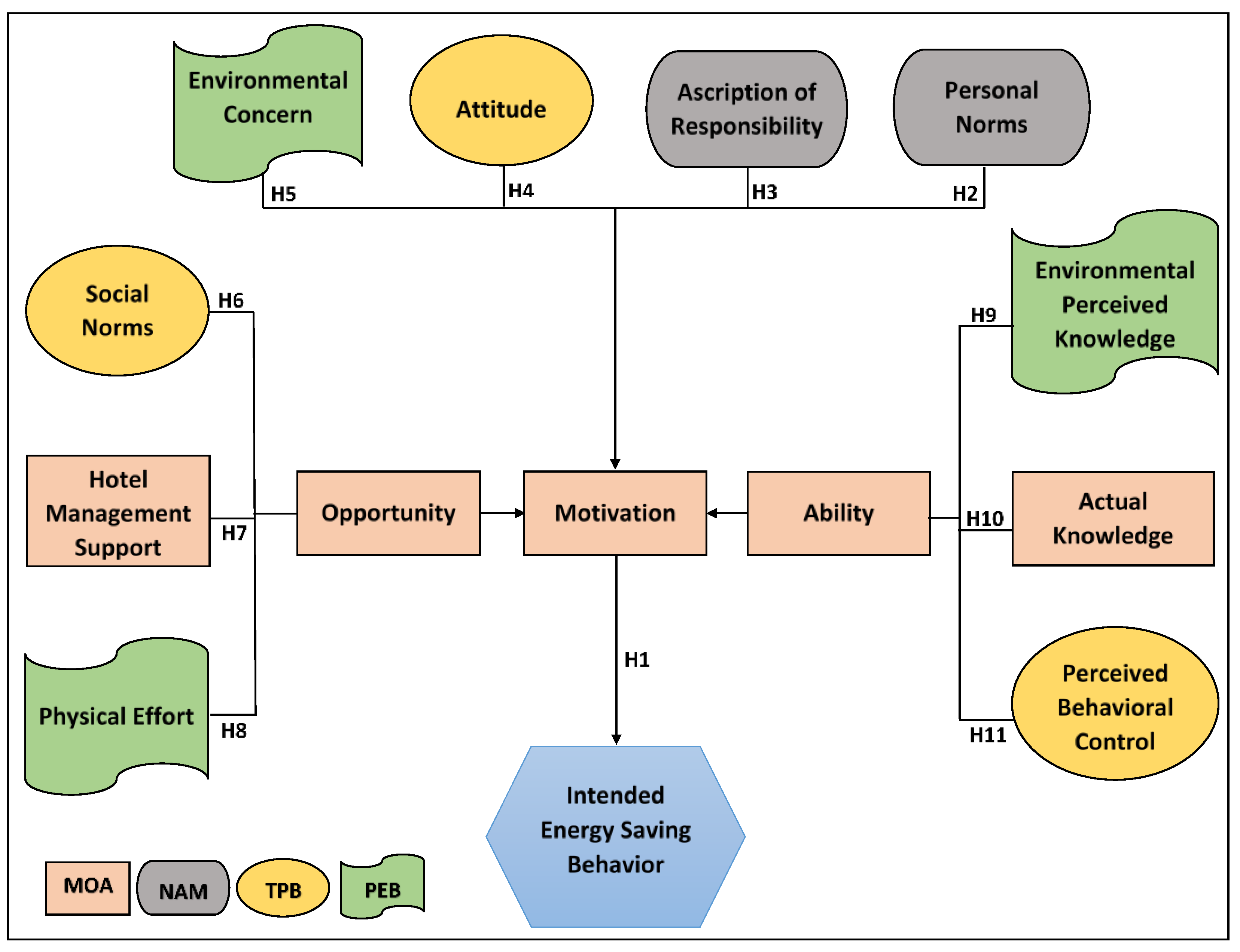


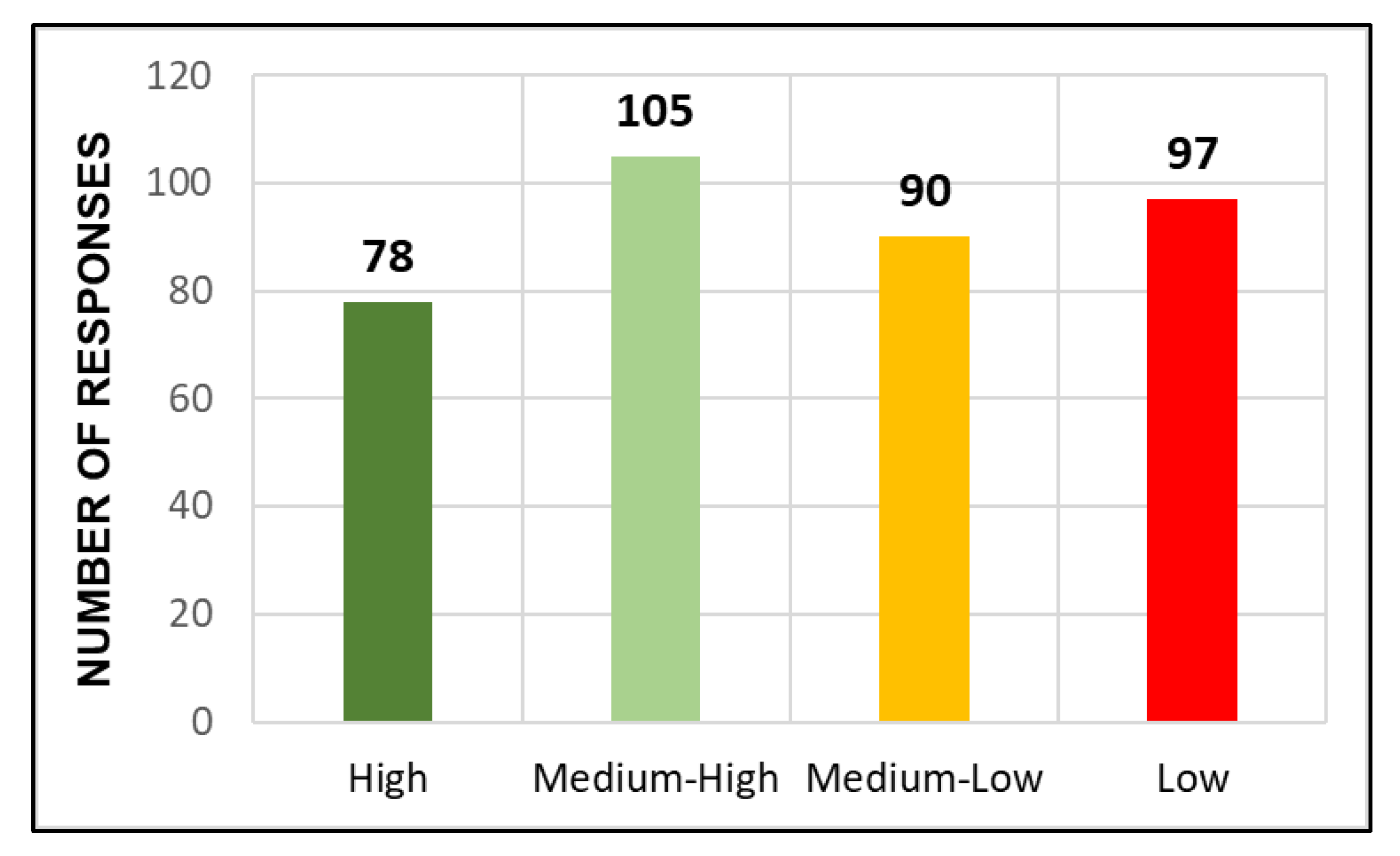


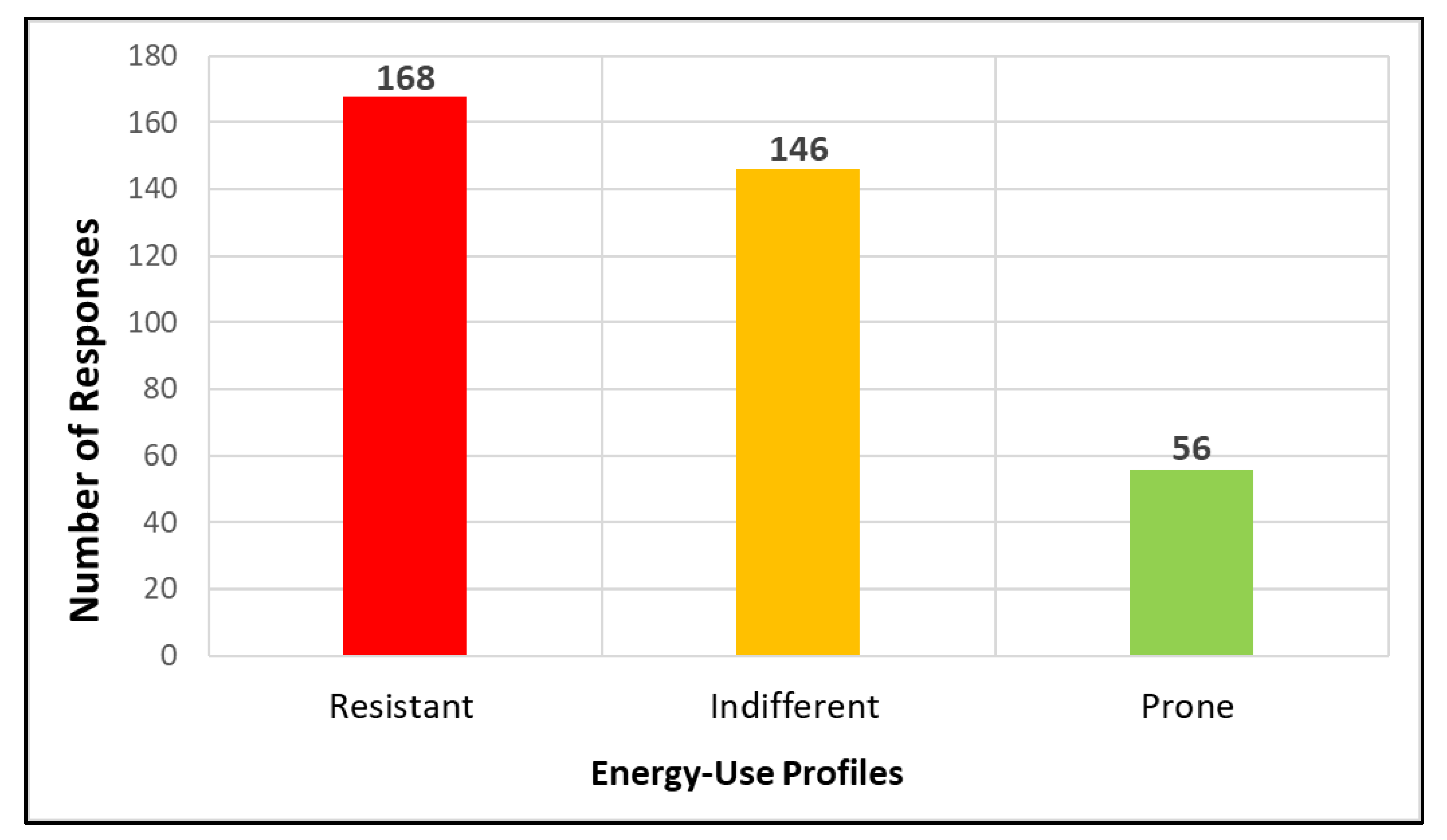


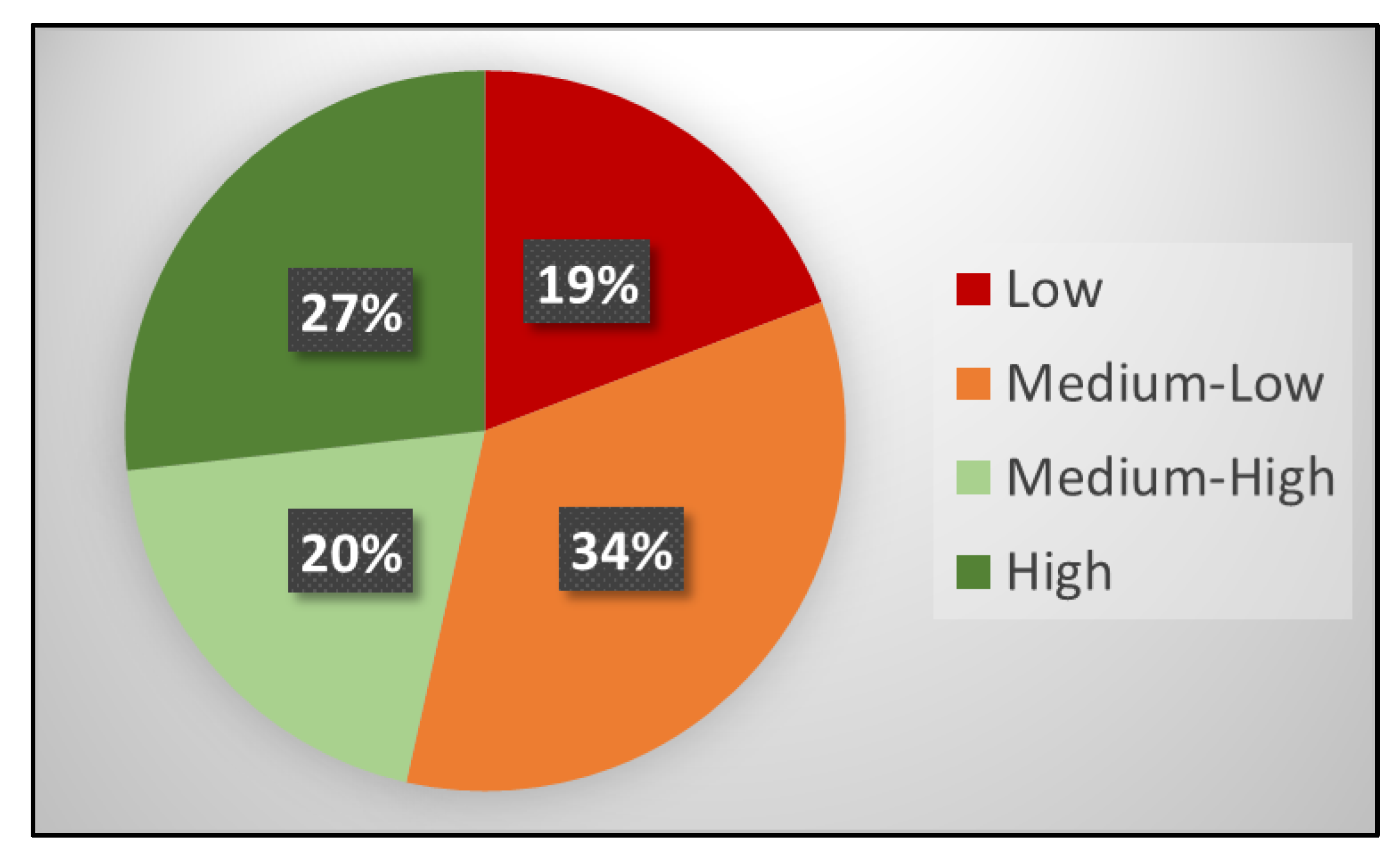
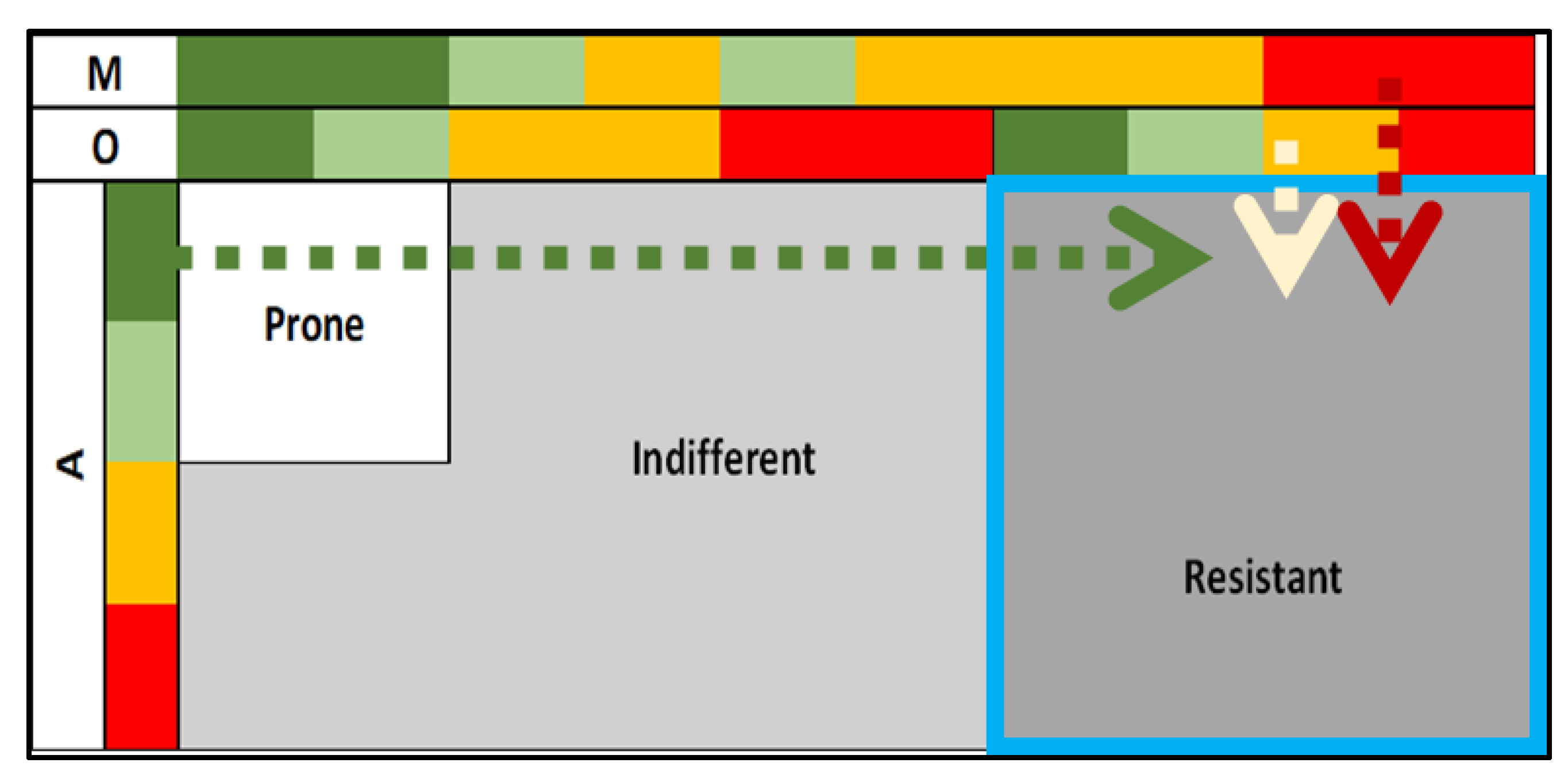
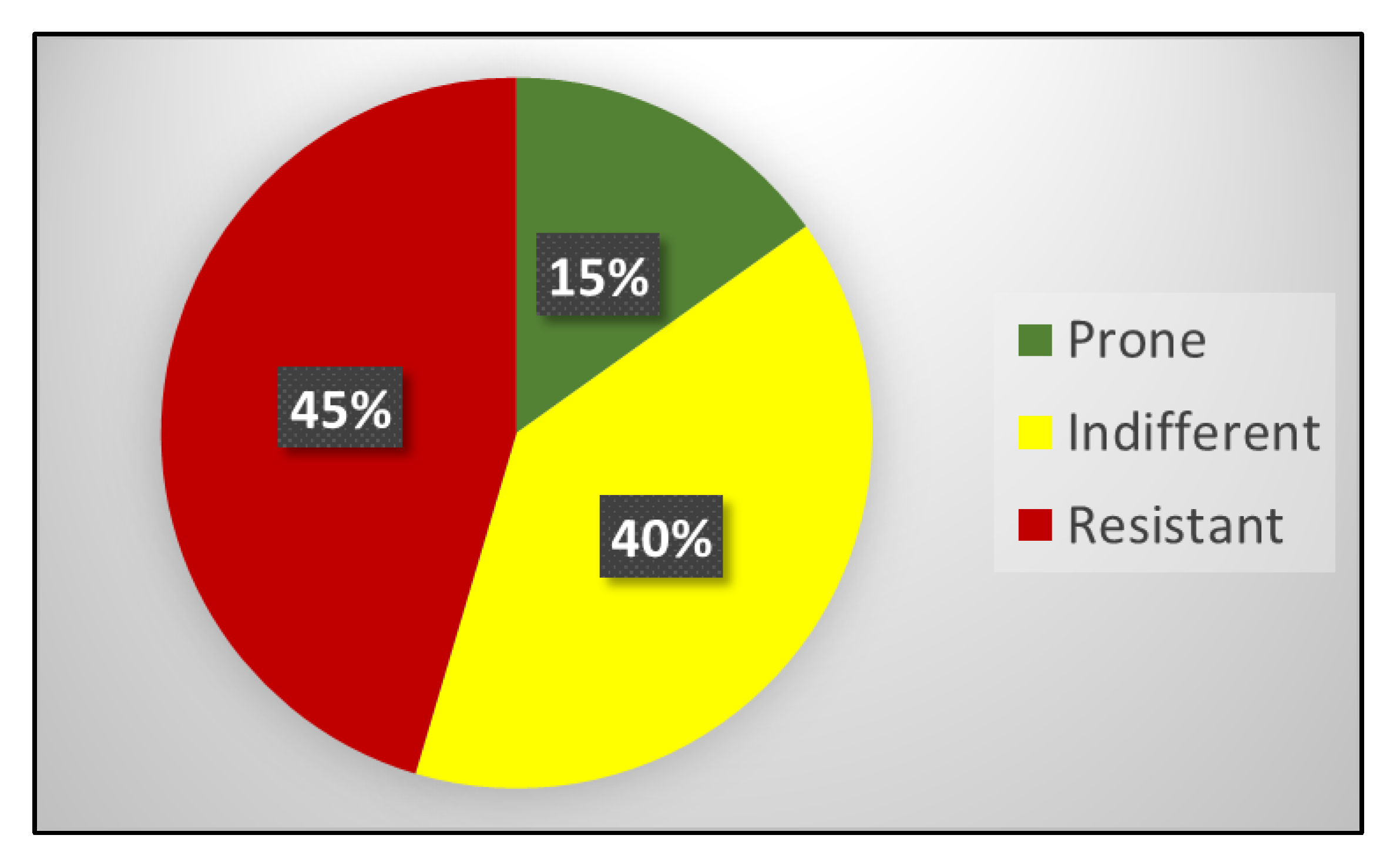
| Research Hypothesis | MOA Level | Energy-Use Behavior Model | Measures | References |
|---|---|---|---|---|
| H1 | M | MOA | Adjusting lighting control. Adjusting indoor climate conditions. Adopting energy conservation strategies. Personal motivation. | [7,8,23,59,60,61] |
| H2 | M | NAM | Hotel guests’ moral obligation to reduce energy consumption in their hotel room. | [8,25,41,62,63,64,65,66] |
| H3 | M | NAM | Hotel guest’s degree of responsibility. | [8,41,64,66,67] |
| H4 | M | TPB | Positive and negative energy conservation attitudes of hotel guests. | [26,41,63,64,68] |
| H5 | M | PEB | Environmental concern levels of hotel guests. | [63,69,70] |
| Research Hypothesis | MOA Level | Energy-Use Behavior Model | Measures | References |
|---|---|---|---|---|
| H6 | O | TPB | Hotel management’s expectations toward hotel guest’s energy conservation behavior (e.g., lighting control, adjusting indoor climate conditions, and window blinder control). Room companion(s) expectations toward hotel guest’s energy conservation behavior (e.g., lighting control, adjusting indoor climate conditions, and window blinder control). Peer pressure. Room companion(s) concern level about energy consumption in the hotel room. | [26,62,63,64,68] |
| H7 | O | MOA | Hotel management’s policy, regulations, and/or recommendations provided to hotel guests about reducing their energy consumption. | [8] |
| H8 | O | PEB | Physical efforts to conduct energy saving behaviors that are not bothersome or inconvenient to the hotel guest in the hotel room. | [14,32,71] |
| Research Hypothesis | MOA Level | Energy-Use Behavior Model | Measures | References |
|---|---|---|---|---|
| H9 | A | PEB | Perceived self-knowledge capacity of energy conservation. Perceived self-knowledge capacity of adjusting indoor climate conditions (HVAC system). Perceived self-knowledge capacity of lighting usage. | [7,8,23,29,35,41,59,60,61] |
| H10 | A | MOA | Knowledge of plug loads. Knowledge of adjusting indoor climate conditions (HVAC). Knowledge of lighting controls. Knowledge of energy conservation strategies. Knowledge of renewable resources. | [7,8,59,60,61] |
| H11 | A | TPB | Hotel guest’s physical capability and perceived ease to enact a behavior. Hotel management’s physical capability and perceived ease to enact a behavior. | [62,63] |
| Energy-Use Profile | Incentives |
|---|---|
| Prone to Change | - |
| Indifferent to Change | Free Soft Drink, Hotel Room Upgrade, Free VIP Parking, Free Roll-up Bed |
| Resistant to Change | Meal Coupon for in Hotel Use, Discounts for Future Stays, Free Soft Drink Coupon, Travel Point on Hotel Reward Card |
Publisher’s Note: MDPI stays neutral with regard to jurisdictional claims in published maps and institutional affiliations. |
© 2021 by the authors. Licensee MDPI, Basel, Switzerland. This article is an open access article distributed under the terms and conditions of the Creative Commons Attribution (CC BY) license (https://creativecommons.org/licenses/by/4.0/).
Share and Cite
Palani, H.; Karatas, A. Identifying Energy-Use Behavior and Energy-Use Profiles of Hotel Guests. Appl. Sci. 2021, 11, 6093. https://doi.org/10.3390/app11136093
Palani H, Karatas A. Identifying Energy-Use Behavior and Energy-Use Profiles of Hotel Guests. Applied Sciences. 2021; 11(13):6093. https://doi.org/10.3390/app11136093
Chicago/Turabian StylePalani, Hevar, and Aslihan Karatas. 2021. "Identifying Energy-Use Behavior and Energy-Use Profiles of Hotel Guests" Applied Sciences 11, no. 13: 6093. https://doi.org/10.3390/app11136093
APA StylePalani, H., & Karatas, A. (2021). Identifying Energy-Use Behavior and Energy-Use Profiles of Hotel Guests. Applied Sciences, 11(13), 6093. https://doi.org/10.3390/app11136093







